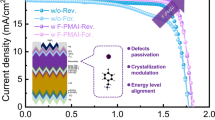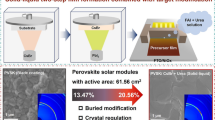Abstract
Highly transparent and crystallized nickel oxide thin film through magnetron sputtering is incorporated in CH3NH3PbI3 planar heterojunction perovskite solar cells (PSCs). In this work, the influence of substrate temperature on NiO film during magnetron sputtering and corresponding performance of PSCs were investigated. NiO thin films were prepared with different substrate temperatures, i.e., 20 °C, 150 °C, and 300 °C, named as 20-NiO, 150-NiO, and 300-NiO, separately. It is found that higher substrate temperature leads to better crystallinity of NiO film, and corresponding a higher PSCs efficiency. PSCs based on 300-NiO thin films’ inorganic hole transport layer show the best efficiency (up to 14.11%), which is about 32% higher than that of device based on 20-NiO. This is mainly due to the fact of 300-NiO thin films with the better light transmittance and higher hole mobility, promoting light absorption and photo-generated charge separation efficiency of perovskite layer, which leads to an improvement in device performance.







Similar content being viewed by others

References
N.J. Jeon, J.H. Noh, W.S. Yang et al., Compositional engineering of perovskite materials for high-performance solar cells. Nature 517(7535), 476–480 (2015)
W.S. Yang, J.H. Noh, N.J. Jeon et al., High-performance photovoltaic perovskite layers fabricated through intramolecular exchange. Science 348(6240), 1234–1237 (2015)
B.W. Park, N. Kedem, M. Kulbak et al., Understanding how excess lead iodide precursor improves halide perovskite solar cell performance. Nat. Commun. 9(1), 3301–3308 (2018)
A. Kojima, K. Teshima, Y. Shirai et al., Organometal halide perovskites as visible-light sensitizers for photovoltaic cells. J. Am. Chem. Soc. 131(17), 6050–6051 (2009)
W.S. Yang, B.W. Park, E.H. Jung et al., Iodide management in formamidinium-lead-halide-based perovskite layers for efficient solar cells. Science 356(6345), 1376–1379 (2017)
Q. Xi, G. Gao, H. Zhou et al., Highly efficient inverted perovskite solar cells mediated by electrodeposition-processed NiO NPs hole-selective contact with different energy structure and surface property. Appl. Surf. Sci. 463, 1107–1116 (2019)
H. Tan, A. Jain, O. Voznyy, S. Hoogland, E.H. Sargent et al., Efficient and stable solution-processed planar perovskite solar cells via contact passivation. Science 355(6326), 722–726 (2017)
Q. Zhang, L. Chu, F. Zhou et al., Excitonic properties of chemically synthesized 2d organic-inorganic hybrid perovskite nanosheets. Adv. Mater. 30(18), e1704055 (2018)
J. Kim, S.H. Lee, J.H. Lee et al., The role of intrinsic defects in methylammonium lead iodide perovskite. J. Phys. Chem. Lett. 5(8), 1312–1317 (2014)
K.A. Bush, A.F. Palmstrom, Z.J. Yu et al., 23.6%-efficient monolithic perovskite/silicon tandem solar cells with improved stability. Nat. Energy 2(4), 17009 (2017)
A. Echresh, C.O. Chey, M.Z. Shoushtari et al., UV photo-detector based on p-NiO thin film/n-ZnO nanorods heterojunction prepared by a simple process. J. Alloy. Compd. 632, 165–171 (2015)
G. Evmenenko, T.T. Fister, D.B. Buchholz et al., Morphological evolution of multilayer Ni/NiO thin film electrodes during lithiation. ACS Appl. Mater. Interfaces. 8(31), 19979–19986 (2016)
A. Liu, H. Zhu, Z. Guo et al., Solution combustion synthesis: low-temperature processing for p type Cu:NiO thin films for transparent electronics. Adv. Mater. 29(34), 1701599 (2017)
X. Guo, G. Luo, J. Liu et al., A 16.5% efficient perovskite solar cells with inorganic NiO film as hole transport material. IEEE J. Photovolt. 8(4), 1039–1043 (2018)
H.Y. Hsu, C.Y. Wang, A. Fathi et al., Femtosecond excitonic relaxation dynamics of perovskite on mesoporous films of Al2O3 and NiO nanoparticles. Angew. Chem. Int. Edit. 53(35), 9339–9342 (2014)
H. Zhang, J. Cheng, F. Lin et al., Pinhole-free and surface-nanostructured NiOx film by room-temperature solution process for high-performance flexible perovskite solar cells with good stability and reproducibility. ACS Nano 10(1), 1503–1511 (2016)
K.S. Usha, R. Sivakumar, C. Sanjeeviraja et al., Improved electrochromic performance of a radio frequency magnetron sputtered NiO thin film with high optical switching speed. RSC Adv. 6(83), 79668–79680 (2016)
Z.J. Hu, D. Chen, P. Yang et al., Sol-gel-processed yttrium-doped NiO as hole transport layer in inverted perovskite solar cells for enhanced performance. Appl. Surf. Sci. 441, 258–264 (2018)
W. Chen, Y.Z. Wu, Y.F. Yue et al., Efficient and stable large-area perovskite solar cells with inorganic charge extraction layers. Science 350(6263), 944–948 (2015)
K.L. Nardi, N. Yang, C.F. Dickens et al., Creating highly active atomic layer deposited NiO electrocatalysts for the oxygen evolution reaction. Adv. Energy Mater. 5(17), 1500412x (2015)
J.H. Park, J. Seo, S. Park et al., Efficient CH3NH3PbI3 perovskite solar cells employing nanostructured p type NiO electrode formed by a pulsed laser deposition. Adv. Mater. 27, 4013–4019 (2015)
S. Seo, I.J. Park, M. Kim et al., An ultra-thin, un-doped NiO hole transporting layer of highly efficient (16.4%) organic-inorganic hybrid perovskite solar cells. Nanoscale 8(22), 11403–11412 (2016)
C.H. Hou, J.J. Shyue, W.F. Su et al., Catalytic metal-induced crystallization of sol-gel metal oxides for high-efficiency flexible perovskite solar cells. J. Mater. Chem. A 6(34), 16450–16457 (2018)
E. Aydin, J. Troughton, M.D. Bastiani et al., Room-temperature-sputtered nanocrystalline nickel oxide as hole transport layer for p-i-n perovskite solar cells. ACS Appl. Energy Mater. 1(11), 6227–6233 (2018)
L. Chu, W. Liu, Z.F. Qin et al., Boosting efficiency of hole conductor-free perovskite solar cells by incorporating p-type NiO nanoparticles into carbon electrodes. Sol. Energy Mater. Sol. Cell 178, 164–169 (2018)
W. Qin, E. Morteza, Z. Ting et al., Achieving fully blade-coated ambient-processed perovskite solar cells by controlling the blade-coater temperature. IEEE J. Photovolt. 8(6), 1662–1669 (2018)
Q. Wang, C.C. Chueh, T. Zhao et al., Effects of self-assembled monolayer modification of nickel oxide nanoparticles layer on the performance and application of inverted perovskite solar cells. Chemsuschem 10(19), 3794–3803 (2017)
Z. Yu, L.C. Sun, Inorganic hole-transporting materials for perovskite solar cells. Small Methods 2(2), 1700280 (2018)
J. Cui, F.P. Meng, H. Zhang et al., CH3NH3PbI3-based planar solar cells with magnetron-sputtered nickel oxide. ACS Appl. Mater. Interfaces 6(24), 22862–22870 (2014)
K.C. Wang, P.S. Shen, M.H. Li et al., Low-temperature sputtered nickel oxide compact thin film as effective electron blocking layer for mesoscopic NiO/CH3NH3PbI3 perovskite heterojunction solar cells. ACS Appl. Mater. Interfaces 6(15), 11851–11858 (2014)
S.D. Stranks, H.J. Snaith, Metal-halide perovskites for photovoltaic and light-emitting devices. Nat. Nanotechnol. 10(5), 391–402 (2015)
S. Yakunin, L. Protesescu, F. Krieg et al., Low-threshold amplified spontaneous emission and lasing from colloidal nanocrystals of caesium lead halide perovskites. Nat. Commun. 6, 8056–8063 (2015)
J. Zhang, W. Mao, X. Hou et al., Solution-processed Sr-doped NiOx as hole transport layer for efficient and stable perovskite solar cells. Sol. Energy 174, 1133–1141 (2018)
J. Cao, H. Yu, S. Zhou et al., Low-temperature solution-processed NiOx film for air-stable perovskite solar cells. J. Mater. Chem. 5(22), 11071–11077 (2017)
Z. Shi, A. Jayatissa, Perovskites-based solar cells: a review of recent progress materials and processing methods. Mater. 11(5), 729 (2018)
Y.S. Wang, T. Mahmoudi, W.Y. Rho et al., Ambient-air-solution-processed efficient and highly stable perovskite solar cells based on CH3NH3PbI3-xClx-NiO composite with Al2O3/NiO interfacial engineering. Nano Energy 40, 408–417 (2017)
Acknowledgements
This work is financially supported by the National Natural Science Foundation of China (no. 51602293 and 11705168).
Author information
Authors and Affiliations
Corresponding author
Additional information
Publisher's Note
Springer Nature remains neutral with regard to jurisdictional claims in published maps and institutional affiliations.
Rights and permissions
About this article
Cite this article
Yang, P., Wang, J., Zhao, X. et al. Magnetron-sputtered nickel oxide films as hole transport layer for planar heterojunction perovskite solar cells. Appl. Phys. A 125, 481 (2019). https://doi.org/10.1007/s00339-019-2769-4
Received:
Accepted:
Published:
DOI: https://doi.org/10.1007/s00339-019-2769-4



